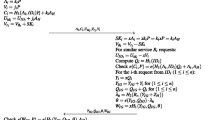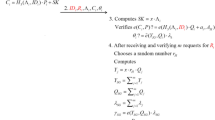Abstract
To guarantee the secure access by authorized subscribers in mobile pay-TV systems, user authentication is required. User authentication is a security mechanism used to verify the identity of a legal subscriber. In 2012, Yeh and Tsaur proposed an authentication scheme for access control in mobile pay-TV systems to improve the Sun and Leu’s scheme. Yeh and Tsaur claimed that their scheme meets all security requirements for mobile pay-TV systems. However, this paper indicates that Yeh and Tsaur’s scheme suffers from some critical weaknesses. An attacker without knowing secret information can successfully impersonate both mobile sets and head-end system. As a remedy, we propose an improved authentication scheme for mobile pay-TV systems using bilinear pairings. The proposed scheme maintains the merits and covers the demerits of the previous schemes, and provides a higher level of the efficiency for mobile pay-TV systems.

Similar content being viewed by others
References
Bayat M, Farash M-S, Movahed A (2010) A novel secure bilinear pairing based remote user authentication scheme with smart card. In: IEEE/IFIP international conference on embedded and ubiquitous computing (EUC), pp 578–582
Chen T-H, Chen Y-C, Shih W-K, Wei H-W (2011) An efficient anonymous authentication protocol for mobile pay-TV. J Netw Comput Appl 34(4):1131–1137
Conditional-Access Broadcasting System (1992) ITU-R Rec. 810
Digital Video Broadcasting (DVB) (2007) IP datacast over DVB-H: service purchase and protection, ETSI TS 102 474 v1.1.1 Std
Farash M-S, Attari M-A (2013) Provably secure and efficient identity-based key agreement protocol for independent PKGs using ECC. ISC Int J Inform Secur 5(1):18–43
Farash M-S, Attari M-A (2013) An enhanced authenticated key agreement for session initiation protocol. Inf Technol Control 42(4):333–342
Farash M-S, Attari M-A (2013) Cryptanalysis and improvement of a chaotic maps-based key agreement protocol using Chebyshev sequence membership testing. Nonlinear Dyn 76(2):1203–1213
Farash M-S, Attari M-A (2014) An efficient and provably secure three-party password-based authenticated key exchange protocol based on Chebyshev chaotic maps. Nonlinear Dyn 77(1-2):399–411
Farash M-S, Attari M-A (2014) An enhanced and secure three-party password-based authenticated key exchange protocol without using server’s public-keys and symmetric cryptosystems. Inf Technol Control 43 (2):143–150
Farash M-S, Attari M-A (2014) Cryptanalysis and improvement of an efficient mutual authentication RFID scheme based on elliptic curve cryptography. J Supercomput. doi:10.1007/s11227-014-1272-0
Farash M-S, Attari M-A (2014) An efficient client-client password-based authentication scheme with provable security. J Supercomput. doi:10.1007/s11227-014-1273-z
Farash M-S, Attari M-A (2014) A pairing-free ID-based key agreement protocol with different PKGs. Int J Netw Secur 16(2):143–148
Farash M-S, Attari M-A (2014) secure and efficient identity-based authenticated key exchange protocol for mobile client-server networks. J Supercomput 69(1):395–411
Farash M-S, Attari M-A, Bayat M (2012) A certificateless multiple-key agreement protocol without one-way hash functions based on bilinear pairings. IACSIT Int J Eng Technol 4(3):321–325
Farash M-S, Bayat M, Attari M-A (2011) Vulnerability of two multiple-key agreement protocols. Comput Electr Eng 37(2):199–204
Farash M-S, Attari M-A, Atani R-E, Jami M (2013) A new efficient authenticated multiple-key exchange protocol from bilinear pairings. Comput Electr Eng 39(2):530–541
Huang X, Chu C-K, Sun H-M, Zhou J, Deng R-H (2012) Enhanced authentication for commercial video services. Secur Commun Netw 5(11):1248–1259
Jiang Y, Shi M, Shen X, Lin C (2009) BAT: a robust signature scheme for vehicular networks using binary authentication tree. IEEE Trans Wirel Commun 8(4):1974–1983
Kim J-Y, Choi H-K (2010) Improvements on Sun’s conditional access system in pay-TV broadcasting systems. IEEE Trans Multimedia 12(4):337–340
Lee N, Chang C, Lin C, Hwang T. (2000) Privacy and non-repudiation on pay-TV systems. IEEE Trans Consum Electron 46(1):20–27
Liu X, Zhang Y (2013) A privacy?preserving acceleration authentication protocol for mobile pay-TV systems. Secur Commun Netw 6(3):361–372
Michon V, Coutrot F (1989) A single conditional access system for satellite-cable and terrestrial TV. IEEE Trans Consum Electron 35(3):464
Pointcheval D, Stern J (1996) Security proofs for signature schemes. In: Maurer U M (ed) EUROCRYPT 1996. LNCS, vol 1070. Springer, Heidelberg, pp 387–398
Scott M, Costigan N, Abdulwahab W (2006) Implementing cryptographic pairings on smartcards. In: Cryptographic Hardware and Embedded Systems-CHES 2006:134–147
Song R, Korba L (2003) Pay-TV system with strong privacy and non-repudiation protection. IEEE Trans Consum Electron 49(2):408–413
Sun H-M, Leu M-C (2009) An efficient authentication scheme for access control in mobile pay-TV systems. IEEE Trans Multimedia 11(5):947–959
Sun H-M, Chen C-M, Shieh C-Z (2008) Flexible-pay-per-channel: a new model for content access control in pay-TV broadcasting systems. IEEE Trans Multimedia 10(6):1109–1120
Wang S-Y, Laih C-S (2008) Efficient key distribution for access control in pay-TV systems. IEEE Trans Multimedia 10(3):480–492
Wang H, Qin B (2012) Improved one-to-many authentication scheme for access control in pay-TV systems. IET Inf Secur 6(4):281–290
Yang J-H, Chang C-C (2009) An ID-based remote mutual authentication with key agreement scheme for mobile devices on elliptic curve cryptosystem. Comput secur 28(3):138–143
Yeh L-Y, Tsaur W (2012) A secure and efficient authentication scheme for access control in mobile pay-TV systems. IEEE Trans Multimedia 14(6):1690–1693
Yeung S-F, Lui J-C, Yau D-K (2005) A multikey secure multimedia proxy using asymmetric reversible parametric sequences: theory, design, and implementation. IEEE Trans Multimedia 7(2):330–338
Author information
Authors and Affiliations
Corresponding author
Rights and permissions
About this article
Cite this article
Farash, M.S., Attari, M.A. A provably secure and efficient authentication scheme for access control in mobile pay-TV systems. Multimed Tools Appl 75, 405–424 (2016). https://doi.org/10.1007/s11042-014-2296-4
Received:
Revised:
Accepted:
Published:
Issue Date:
DOI: https://doi.org/10.1007/s11042-014-2296-4




